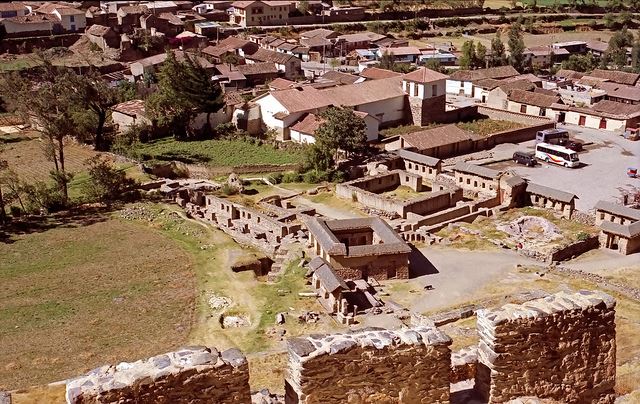


Everywhere I look I see history. From the narrow cobblestone pathways beneath my feet to the Incan storehouses dotting the hillsides, it is inescapable I’m in a village that has been around for half a millennium. Peru as a whole certainly doesn’t lack for ancient features — Cusco itself was the capital of the mighty Incan Empire — but the tiny Sacred Valley town of Ollantaytambo encompasses the true essence of antiquity persevering.
Section Type: imageOnLeftParagraphToRight
Sitting in the quaint center square, stout locals with rainbow-colored skirts billowing at the waist pass me by, some selling local delicacies, but most simply going about their daily business. In the surrounding hillsides, fields are furrowed with foot-plows and the sweat of the brow, and in backyards pens, cuy scurry about, perhaps anticipating their final dinner plate destination. Continuously occupied since the 13th century — long before the arrival of the Incas and later the Spaniards — Ollantaytambo seems untouched by time.

Across the Patacancha River and peeking out over clay tiled roofs that blaze from dusty brown to burnt orange in the midday sun, I see the ruins that draw the daily tourists. Surrounded by steep terraces — a giant-sized staircase to the sky — the former Incan fortress looms over the town like a stoic sentry. Built under the command of 15th-century Incan Emperor Pachacuti, the complex served as a ceremonial center and royal estate. Though the architecture is precise and impressive, it was the compound’s fortitude against the Spanish that gained it lasting fame.
This is the site of a major Spanish defeat; after retreating from Cusco, Manco Inca faced Hernando Pizarro here in 1536. In an ingenious move, the Incas manipulated the Urubamba River and local aqueducts, flooding the plains below their hillside complex. The Spaniards’ horses floundered in the muddy marsh, halting the assault and forcing a hasty retreat. (The Spanish later returned, tortured Manco Inca’s family, and eventually conquered all of Peru, a story for another day.)
Section Type: imageOnLeftParagraphToRight
Across the valley, on the other side of town, are several additional ruins. Though not included in most day tours, hiking to these ancient Incan storehouses was one of my favorite Ollantaytambo activities. The steep path up the Pinkuylluna mountain begins a few blocks from the town center, on the side opposite of the main ruins. Usually devoid of visitors, this is a rewarding half-day activity, offering spectacular views of Ollantaytambo ruins and city below.
Inca storehouse - Dennis Jarvis

Today, the ruins’ most impressive features include the Sun Temple and the Temple of Ten Niches. The first consists of six massive stone pillars, situated to catch the first rays of the sun, while the latter includes an impeccable and impressively angled stone gateway.
Section Type: cta
Keen to see Ollantaytambo for yourself? Check out our Machu Picchu & Peru tours or speak to one of our Destination Experts about crafting the bespoke vacation of your dreams.


Copyright © 2025 SA Luxury Expeditions LLC, All rights reserved | 95 Third Street, 2nd floor, San Francisco, CA, 94103 | 415-549-8049
California Registered Seller of Travel - CST 2115890-50. Registration as a seller of travel does not constitute approval by the state of California.










